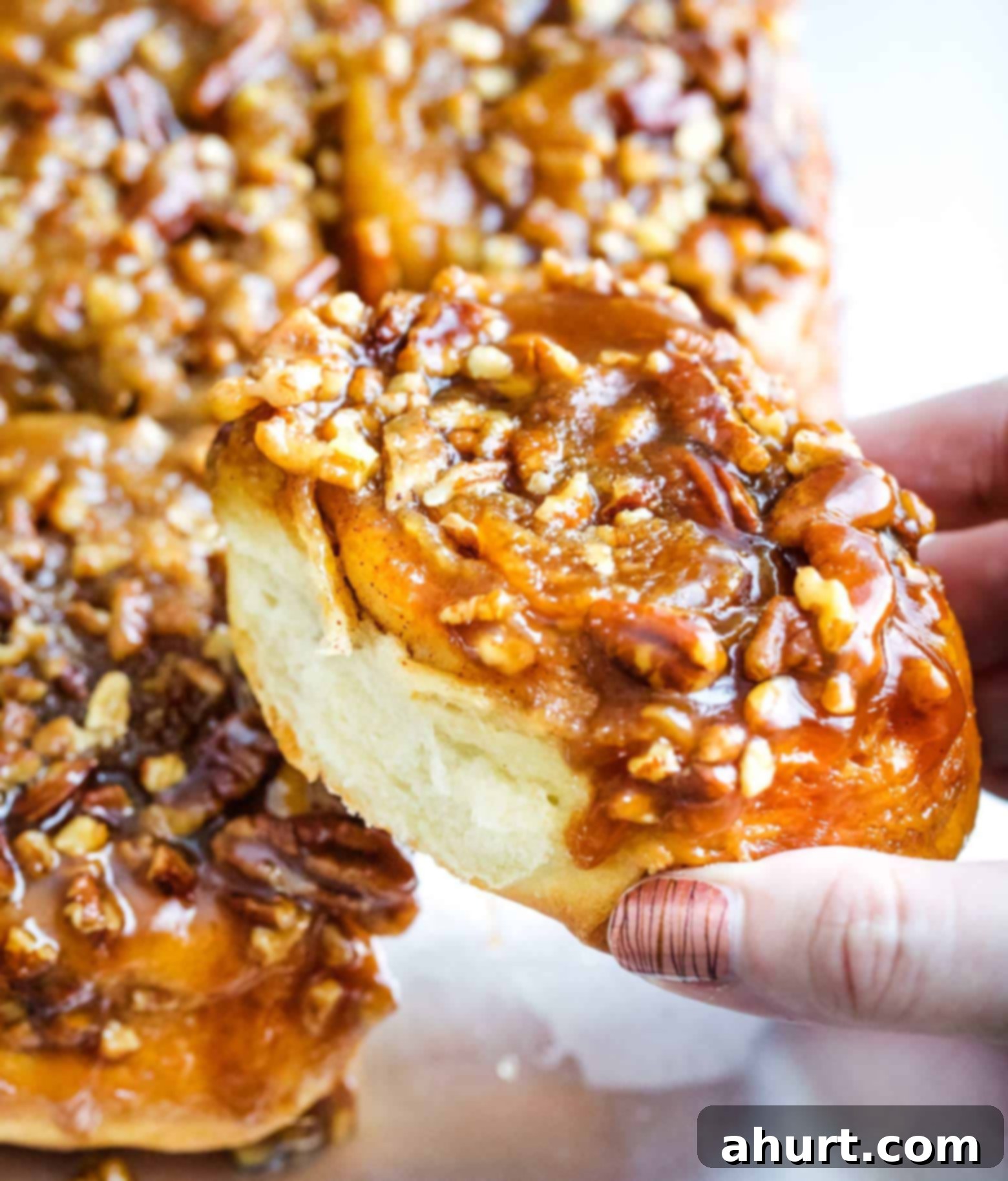Irresistible Maple Pecan Sticky Buns: Your Ultimate Guide to Sweet, Sticky Perfection
Imagine waking up to the comforting aroma of freshly baked goods filling your home. On a chilly morning, or for a special holiday breakfast, there’s nothing quite like the warmth and indulgence of a perfectly crafted sticky bun. These delightful treats are not just a meal; they’re an experience – soft, sweet, and wonderfully sticky, they promise a burst of flavor in every bite. And the best part? They are incredibly fun and rewarding to make right in your own kitchen!
Many people adore classic cinnamon rolls, with their tender dough and sweet frosting. But if you’re looking for an elevated experience, allow us to introduce you to their more decadent cousin: the sticky bun. While both feature a delicious buttery cinnamon sugar filling, sticky buns take indulgence to the next level. Our recipe features a luscious, homemade maple caramel topping generously studded with toasted pecans, creating a symphony of textures and flavors that will captivate your taste buds. This isn’t just a simple pastry; it’s a masterpiece of home baking.
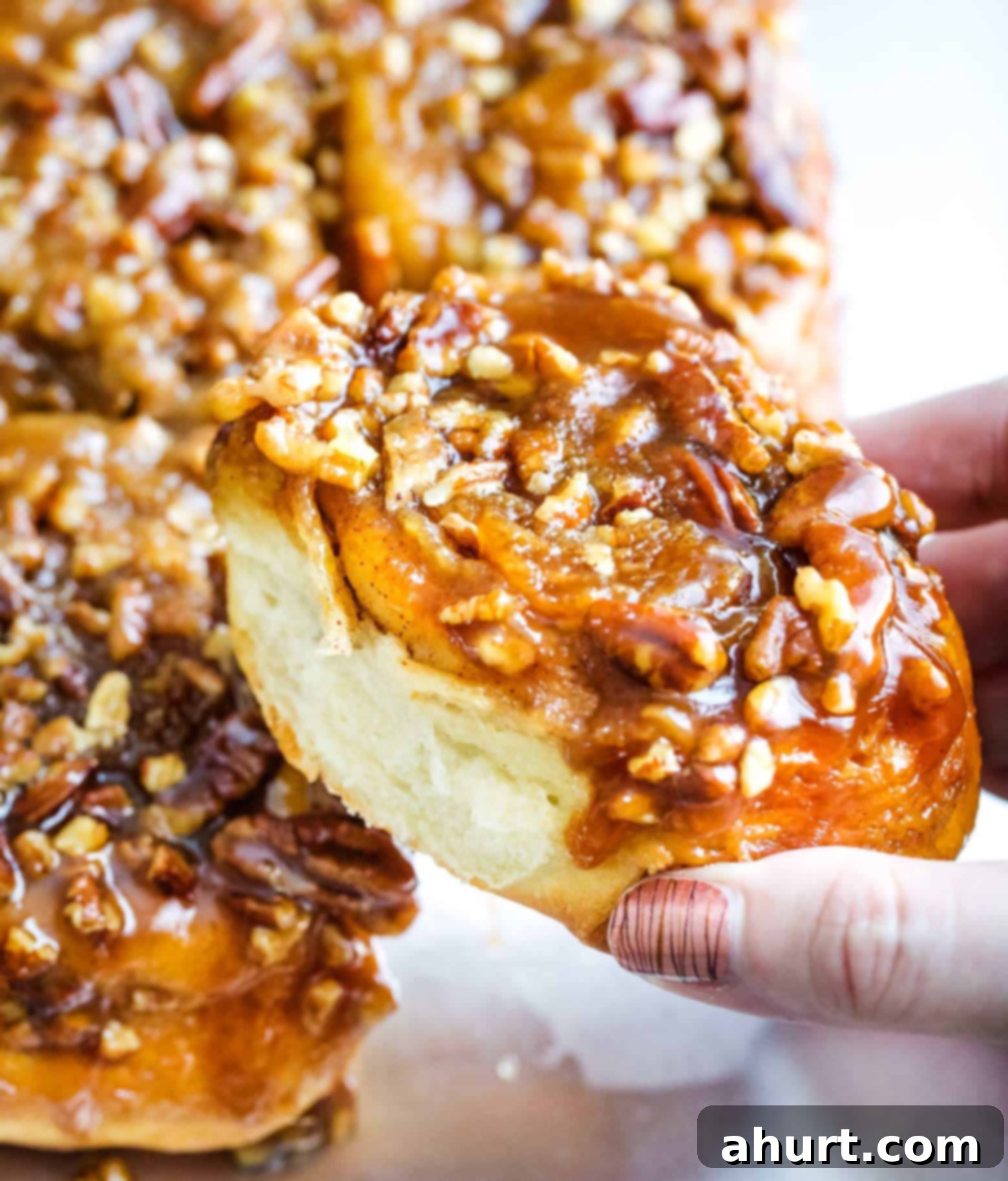
Mastering Maple Pecan Sticky Buns
Hello, fellow food enthusiasts! Amanda here, from The Chunky Chef, your go-to source for comforting family recipes. As a self-taught home cook, I find immense joy in creating fabulous comfort food that brings smiles to everyone’s faces. These Maple Pecan Sticky Buns are a prime example – a labor of love that results in an incredibly satisfying treat perfect for any occasion, from a casual weekend brunch to a festive holiday gathering. Let’s dive into making these incredible sweet rolls together!
Sticky Buns vs. Cinnamon Rolls: Understanding the Delicious Difference
At first glance, sticky buns and cinnamon rolls might seem interchangeable, but there are distinct characteristics that set them apart. Both start with a rich, tender sweet dough and are typically filled with a delightful mixture of butter, brown sugar, and cinnamon. However, the true distinction lies in their glorious toppings and preparation methods.
Cinnamon rolls are traditionally finished with a creamy, often tangy, glaze or icing, frequently made with cream cheese or vanilla. This topping is almost always applied after the rolls have been baked and cooled slightly. The result is a soft, sweet roll with a smooth, sweet finish.
Sticky buns, on the other hand, boast a much richer, more complex topping: a luscious caramel sauce, usually made with butter, brown sugar, and often an additional sweetener like maple syrup or honey. This caramel is typically enhanced with toasted nuts, most commonly pecans, which add a delightful crunch and nutty depth. Crucially, the caramel and nut topping is poured into the bottom of the baking dish before the rolled dough is placed on top. As the buns bake, the caramel bubbles up and seeps into the dough, creating that irresistible sticky, gooey texture. After baking, the pan is inverted, revealing a beautifully coated, caramelized masterpiece. This method ensures every inch of the bun is infused with the sweet, buttery goodness, making them inherently “stickier” and more decadent than their glazed counterparts.
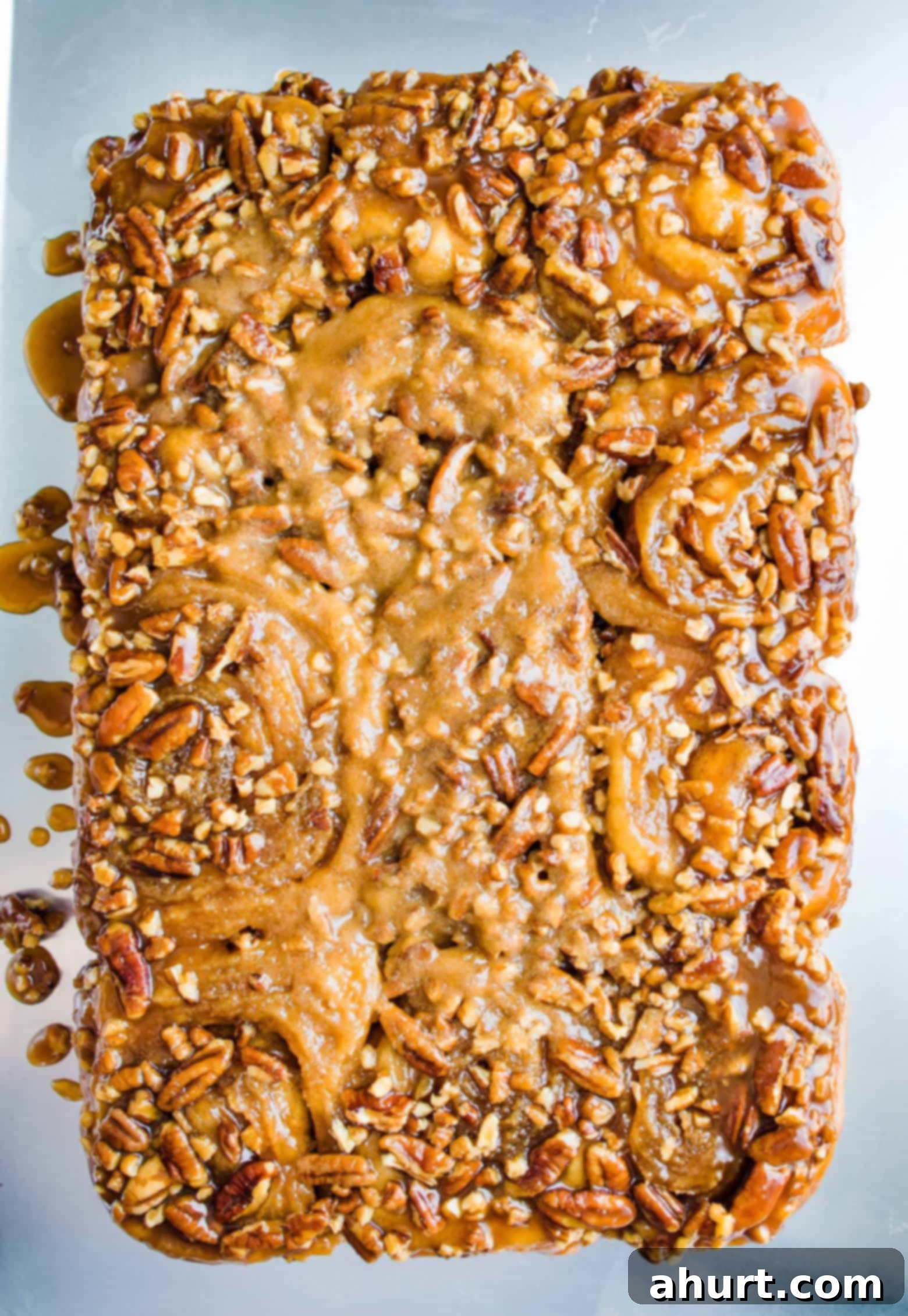
Optimal Storage for Fresh Sticky Buns
While it might be tempting to devour the entire batch of these delectable sticky buns in one sitting (and we wouldn’t blame you!), it’s more likely you’ll have a few leftovers. Proper storage is key to maintaining their incredible taste and texture.
For short-term storage, sticky buns will keep beautifully at room temperature for approximately two days. It’s essential to cover them tightly to prevent them from drying out. An airtight container or wrapping them securely in plastic wrap will work best. If they start to lose a little of their gooeyness, a quick warm-up in the microwave for 10-15 seconds or a few minutes in a low oven (around 250°F / 120°C) will bring them back to life.
For extended freshness, especially in warmer climates, refrigeration is your best bet. Store them in an airtight container in the refrigerator for up to a week. When ready to enjoy, let them come to room temperature for about 30 minutes, then warm them gently in the oven or microwave for that fresh-baked experience.
Can Sticky Buns Be Frozen?
Absolutely! Sticky buns are an excellent candidate for freezing, allowing you to enjoy a homemade treat whenever a craving strikes. While I haven’t personally tested freezing them unbaked, baked sticky buns freeze wonderfully for 2-3 months without compromising their quality.
To freeze, ensure the buns are completely cooled. Wrap each bun individually in plastic wrap, then wrap them again tightly with aluminum foil. For an extra layer of protection against freezer burn, place the foil-wrapped buns in an airtight freezer-safe container or a heavy-duty freezer bag. When you’re ready to enjoy them, thaw the buns overnight in the refrigerator. Once thawed, you can warm them in a preheated oven at 300°F (150°C) for about 10-15 minutes, or until heated through and gooey again. This makes them perfect for meal prepping a special breakfast or having a quick indulgent treat on hand.
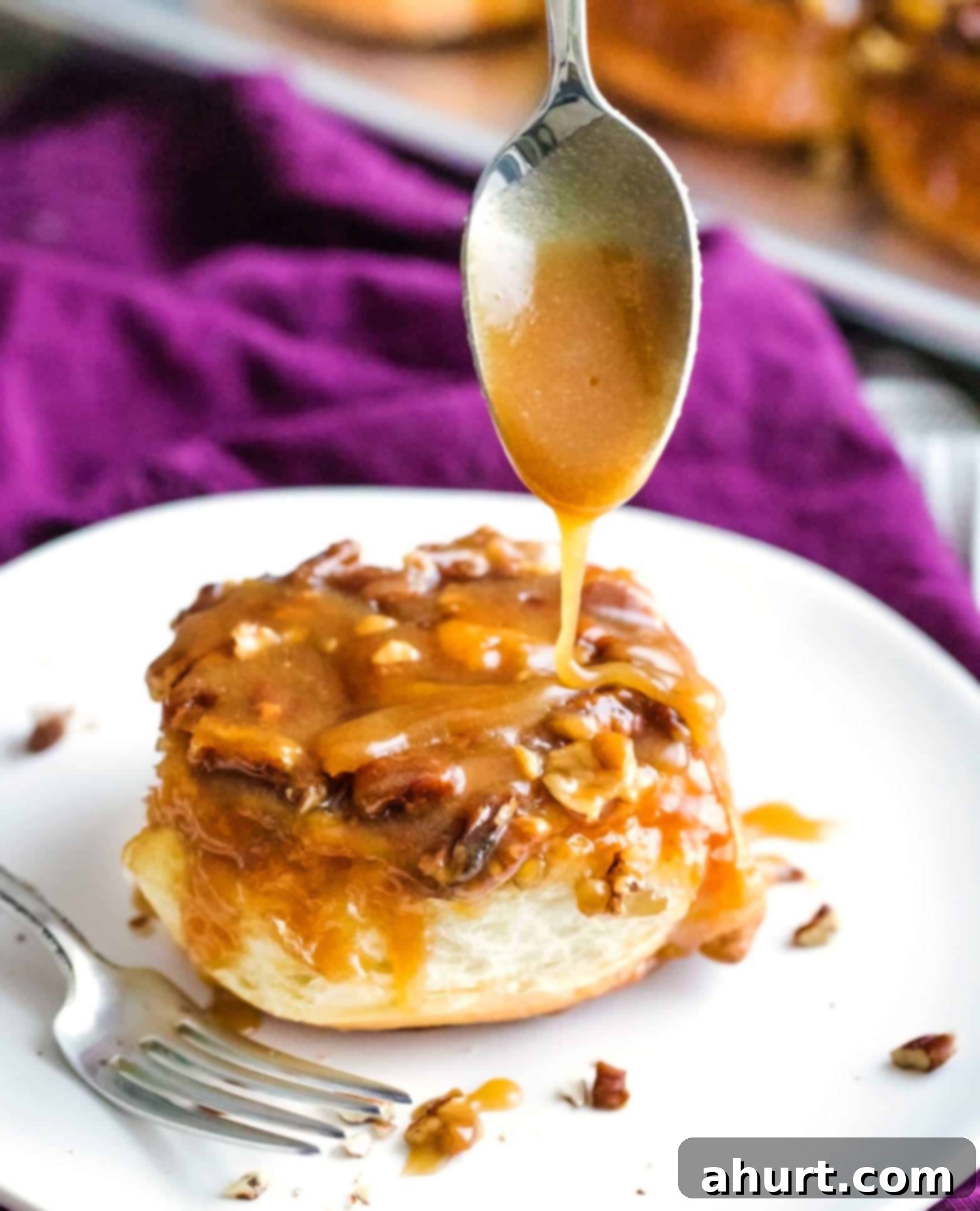
Essential Tips for Baking Perfect Sticky Buns
Baking with yeast might seem daunting to some, but with a few simple tips and tricks, you’ll be creating bakery-quality sticky buns in no time. Don’t be intimidated; the process is incredibly rewarding!
- Embrace Your Stand Mixer (or Your Arm Muscles!): If you own a stand mixer, this is its moment to shine! Kneading dough can be quite a workout, and letting the mixer do the heavy lifting for you will save time and effort, ensuring a consistently smooth, elastic dough. If you don’t have one, no problem! You can absolutely knead the dough by hand; just be prepared for a good arm workout and enjoy the tactile process.
- Always Proof Your Yeast: This step is crucial and shouldn’t be skipped. Proofing simply means activating your yeast in warm liquid with a bit of sugar to confirm it’s alive and active. If your yeast is old or inactive, your dough won’t rise, and you’ll have wasted ingredients and time. Look for a foamy layer on top after 5-10 minutes – that’s your sign of a happy, active yeast ready to get to work!
- Find a Warm Spot for Rising: Yeast loves warmth! If your kitchen is cool, finding a cozy spot for your dough to rise can be a challenge. My foolproof method, especially in colder months, is to preheat my oven to its lowest setting (around 200°F / 95°C) for a few minutes, then turn it off. Place your covered bowl of dough inside the warm, turned-off oven and shut the door. This creates the perfect environment for a quick and consistent rise every time. Just double-check that the oven is OFF before placing the dough inside!
- Achieve Perfect Slices: Slicing the rolled dough log into even rounds can be tricky with a knife, often squishing the shape. For beautifully neat and perfectly round sticky buns, use unflavored dental floss! Seriously, make sure it’s unflavored – nobody wants minty fresh sticky buns! Slide a piece of floss underneath the dough log, bring both ends up, cross them over each other, and pull tightly. This creates clean, precise cuts without deforming your rolls.
- Don’t Rush the Inversion: After baking, it’s tempting to flip the pan immediately. However, allowing the buns to rest for about 5-10 minutes is essential. This brief resting period allows the hot caramel to cool slightly and thicken, ensuring it adheres beautifully to the buns when inverted. If you flip too soon, the caramel will be too runny and might mostly run off the buns, leaving you with less of that glorious sticky topping.
- Bring Ingredients to Room Temperature: For a uniformly smooth dough and even mixing, make sure your butter and eggs are at room temperature as specified in the recipe. This allows them to incorporate fully and evenly with the other ingredients.
- Don’t Over-Knead: While kneading is vital for developing gluten and achieving a tender texture, over-kneading can result in tough buns. Follow the recipe’s recommended kneading times; a soft, elastic dough that springs back when gently poked is what you’re aiming for.
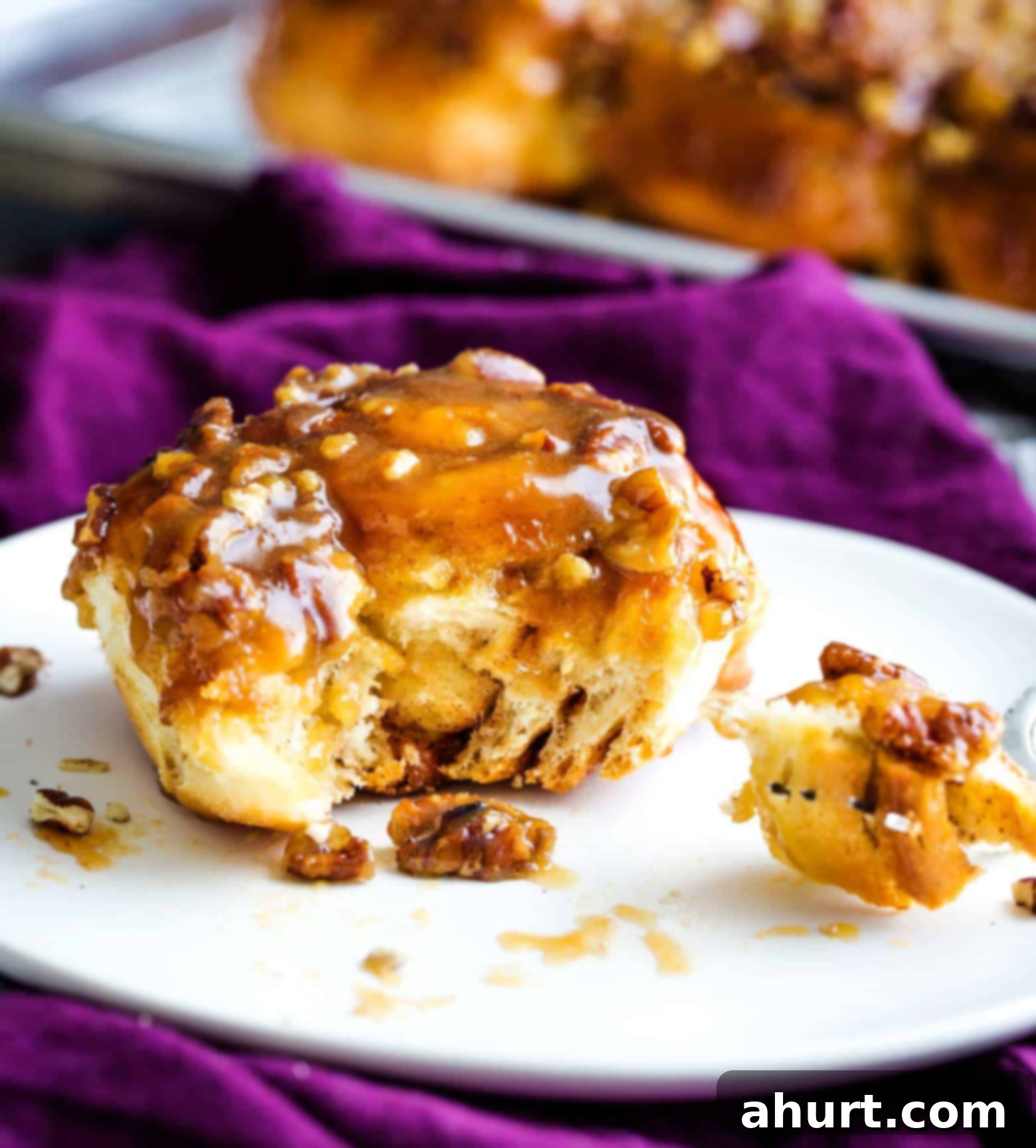
Why Homemade Sticky Buns Are Always Best
There’s a special magic that comes with baking from scratch, especially when it comes to something as comforting as sticky buns. While store-bought options can be convenient, they simply can’t compare to the unparalleled taste, aroma, and satisfaction of homemade. The quality of ingredients you choose, the care you put into each step of the process, and the ability to customize to your liking all contribute to a superior product. Plus, the intoxicating smell of butter, cinnamon, and maple caramel wafting through your home as these bake is a reward in itself. It’s an experience that truly nourishes the soul and creates lasting memories, whether you’re baking for family or friends.
Serving Suggestions & Delightful Variations
These Maple Pecan Sticky Buns are undeniably the star of any breakfast or brunch spread, but they can be elevated even further! Serve them warm, perhaps with a freshly brewed cup of coffee or a comforting mug of tea. For a truly indulgent experience, consider pairing them with fresh berries, a side of crispy bacon, or a dollop of whipped cream. They also make an impressive addition to holiday buffets or potlucks.
Feeling adventurous? Don’t hesitate to experiment with variations! While pecans are traditional, feel free to substitute with walnuts, chopped almonds, or even a mix of nuts. A sprinkle of sea salt over the caramel topping just before baking can enhance the flavor profile, offering a delightful sweet-and-salty contrast. For an extra touch of spice, consider adding a pinch of nutmeg or cardamom to the cinnamon filling. The possibilities are endless!
Troubleshooting Common Sticky Bun Issues
Even seasoned bakers encounter challenges, so don’t fret if something doesn’t go exactly as planned. Here are some quick fixes for common sticky bun issues:
- Dough Didn’t Rise: This is almost always due to inactive yeast or liquid that was too hot (killing the yeast) or too cold (not activating it). Ensure your liquid is lukewarm (around 105-115°F or 40-46°C). If it still doesn’t rise, unfortunately, you’ll likely need to start over with new yeast.
- Buns Are Dry: Over-baking is the main culprit here. Keep an eye on the oven and remove them as soon as they’re golden brown and baked through. Make sure your oven temperature is accurate. Using too much flour during kneading can also lead to a dry dough.
- Caramel Is Too Hard: If your caramel hardens significantly after inverting, it might have been cooked too long or didn’t have enough cream. You can gently reheat the buns (and the caramel) in a warm oven or microwave to soften it up.
- Caramel Is Too Runny: This could be because the caramel wasn’t cooked quite enough, or you inverted the pan too soon after baking. A quick fix for runny caramel once served is to simply spoon it back over the buns.
I genuinely hope you all give these incredible Maple Pecan Sticky Buns a try. I’m confident they’ll become a cherished recipe in your household! For more delicious, comforting recipes, be sure to visit me over at The Chunky Chef. Happy baking!
Looking for more delectable dessert and breakfast ideas? Try these!
Apple Pie Cinnamon Rolls
Soft Cinnamon Rolls
Hot Cross Buns with Chocolate Chips
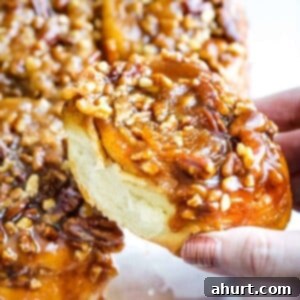
Saved
Pin
Maple Pecan Sticky Buns Recipe
Karina
20 minutes
25 minutes
2 hours 25 minutes
12 servings
Ingredients
DOUGH
- 1 cup whole milk
- 2/3 cup granulated sugar
- 2 packets instant yeast or active dry, about 1 1/2 Tbsp
- 1/2 cup butter softened to room temperature and cut into bite sized pieces
- 2 large eggs
- 1/2 tsp kosher salt
- 4 1/2 cups all purpose flour
FILLING
- 1/3 – 1/2 cup butter softened to room temperature
- 1/2 cup light brown sugar
- 1 1/2 tsp ground cinnamon
TOPPING
- 6 Tbsp butter
- 1 1/4 cup light brown sugar
- 1 tsp vanilla
- 1/4 cup maple syrup
- 3 Tbsp heavy cream
Instructions
MAKE THE DOUGH
-
Lightly grease a large mixing bowl with a drizzle of vegetable oil and set aside. In a small saucepan, gently warm the milk over medium heat until it’s lukewarm (around 105-115°F or 40-46°C). Pour the warm milk into the bowl of a stand mixer and stir in the granulated sugar and yeast. Let this mixture sit for about 5 to 10 minutes; it should become foamy and smell distinctly “yeasty,” indicating your yeast is active.
-
With the mixer on LOW speed, add the softened butter pieces, eggs, and kosher salt.
Gradually add the all-purpose flour, about 1 cup at a time, allowing it to incorporate. Once all the flour has been added, increase the mixer speed to medium and continue mixing for approximately 5 minutes, or until a soft, elastic dough forms that pulls away from the sides of the bowl.
-
Lightly flour your countertop or a clean, flat surface. Transfer the dough onto it, dust your hands with a little flour, and knead by hand for about a minute until the dough is smooth and cohesive. Form the dough into a ball and place it into the prepared, greased mixing bowl. Loosely cover the bowl with plastic wrap, then drape a clean kitchen towel over it. Place in a warm spot (like a turned-off, preheated oven as described in the tips) for about 2 hours, or until the dough has impressively doubled in size.
-
Once the dough has doubled, gently punch it down to release the air. Turn it out onto a lightly floured surface and roll it into a large rectangle, roughly 12×18 inches in dimensions. Ensure the dough is of even thickness using your rolling pin.
MAKE THE FILLING AND ROLL THE BUNS
-
Evenly spread the softened butter over the entire surface of the dough rectangle. In a small bowl, mix the light brown sugar and ground cinnamon. Sprinkle this mixture generously over the buttered dough. Gently use your fingers to pat the sugar/cinnamon mixture down, helping it adhere better during the rolling process.
-
Starting from one of the longer 18-inch sides, tightly roll the dough towards you, creating a snug log. To ensure an even roll, I find it helpful to start rolling at one end, then move slightly down the line, repeating the rolling motion until you’ve worked your way across the entire length of the dough.
Once you have a tightly rolled 18-inch long log, use a very sharp serrated knife or, for best results, unflavored dental floss, to carefully slice the log into 12 evenly sized rolls.
MAKE THE TOPPING, RISE, AND BAKE
-
In a small saucepan, combine the 6 Tbsp butter, 1 1/4 cup light brown sugar, maple syrup, and vanilla extract. Heat over medium heat, stirring occasionally, until the butter is melted and the mixture is smooth and bubbly. Remove from heat and whisk in the heavy cream until fully incorporated. Set this luscious caramel sauce aside.
Generously butter or grease a 9×13 inch baking dish. Pour the prepared caramel sauce into the bottom of the baking dish, tilting the dish to ensure the caramel evenly coats the entire bottom surface.
Evenly sprinkle the pecans over the caramel layer.
-
Carefully arrange the sliced dough rolls on top of the caramel and pecan mixture in the baking dish. Cover the dish tightly with aluminum foil and let the buns rise again for about 45 minutes, or until they look noticeably larger and puffy.
-
Preheat your oven to 375°F (190°C). Once preheated, bake the sticky buns for approximately 25 minutes. If you notice the tops of the rolls are browning too quickly, you can loosely cover them with foil during the second half of the baking time to prevent over-browning.
-
Remove the pan from the oven and let it cool for 7-10 minutes. This resting period is crucial for the caramel to set slightly. After resting, place a large serving tray or sheet pan over the top of the baking dish. Carefully, using oven mitts or heat-safe gloves, hold both the tray and the baking dish firmly together and swiftly flip it over to invert the rolls onto the serving tray. Gently lift off the baking dish, revealing your perfectly caramelized sticky buns.
-
Serve the rolls warm, spooning any extra caramel from the tray over the buns if desired. Enjoy your homemade sticky bun masterpiece!
Notes
- For effortless kneading and consistent dough, utilize a stand mixer if you have one. It significantly reduces the manual effort, yielding a perfectly smooth dough. If you’re without a stand mixer, fear not – manual kneading works just as well and provides a great arm workout!
- Ensure all your cold ingredients, especially milk, butter, and eggs, are at room temperature before starting. This helps them combine smoothly and evenly, leading to a superior dough texture.
- When proofing yeast, the water should be warm to the touch, like a baby’s bath, but not hot (which can kill the yeast) or cold (which won’t activate it).
- Don’t over-flour your surface when rolling out the dough. Too much flour can make the buns dry and tough. Use just enough to prevent sticking.
Nutrition
Carbohydrates: 80g |
Protein: 7g |
Fat: 22g |
Saturated Fat: 13g |
Polyunsaturated Fat: 1g |
Monounsaturated Fat: 6g |
Trans Fat: 1g |
Cholesterol: 87mg |
Sodium: 288mg |
Potassium: 147mg |
Fiber: 1g |
Sugar: 44g |
Vitamin A: 704IU |
Vitamin C: 0.03mg |
Calcium: 74mg |
Iron: 3mg
Nutrition information is automatically calculated, so should only be used as an approximation.
